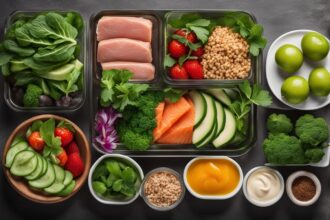Hey there, fellow health enthusiasts! If you’ve been exploring the world of health fasting, you’ve likely heard about its incredible benefits for weight management, mental clarity, and overall wellness. But let’s be real—fasting isn’t always a walk in the park, especially when hunger pangs hit or you’re unsure what to eat during your eating windows. That’s where fasting meal prep comes in as a game-changer. Whether you’re doing intermittent fasting, a 5:2 diet, or extended fasts, preparing meals ahead of time can make your journey smoother, more sustainable, and downright enjoyable. In this guide, I’m diving deep into the art of meal prepping for fasting, blending practical tips with science-backed insights to help you thrive. Let’s get started on how to make fasting for health a seamless part of your lifestyle!
What Is Health Fasting and Why Meal Prep Matters
For the uninitiated, health fasting refers to structured periods of abstaining from food or significantly reducing calorie intake to promote physical and mental well-being. Popular methods include intermittent fasting (like the 16:8 method, where you fast for 16 hours and eat during an 8-hour window) and alternate-day fasting. Research shows fasting can improve insulin sensitivity, support weight loss, and even enhance brain function through processes like autophagy, where cells clean out damaged components (Mattson et al., 2017). But here’s the catch: without a plan, you might end up overeating or grabbing unhealthy options when your eating window opens. Fasting meal prep ensures you have nutritious, balanced meals ready to go, helping you stick to your goals and avoid the pitfalls of poor food choices. It’s all about setting yourself up for success in your healthy fasting diet.
The Science Behind Fasting and Nutrition Needs
Before we dive into meal prep tips, let’s talk about why nutrition during fasting is critical. When you fast, your body shifts into a state of ketosis, burning stored fat for energy instead of glucose (Anton et al., 2018). However, once you break your fast, your body craves nutrients to replenish energy stores, repair tissues, and stabilize blood sugar. Studies suggest that inadequate nutrient intake post-fast can lead to fatigue, muscle loss, or nutrient deficiencies (Trepanowski et al., 2017). That’s why focusing on whole, nutrient-dense foods during your eating windows is non-negotiable for fasting health benefits. Meal prepping allows you to prioritize protein, healthy fats, and complex carbs while avoiding processed junk that could spike your insulin and undo your hard work. Think of it as fueling your body with intention.
Key Principles of Fasting Meal Prep
Now that we’ve covered the ‘why,’ let’s get into the ‘how’ of meal prepping for health fasting. The goal isn’t just to cook in bulk but to create meals that align with your fasting schedule and nutritional needs. Here are some core principles to keep in mind:
- Balance Macronutrients: Include lean proteins (like chicken or tofu), healthy fats (avocado, nuts), and complex carbs (quinoa, sweet potatoes) to keep you full and energized.
- Portion Control: Pre-portion meals to avoid overeating during your eating window, especially if you’re calorie-conscious.
- Hydration First: Prepare infused water or herbal teas to sip on during fasting hours since staying hydrated supports detoxification (Popkin et al., 2010).
- Timing Matters: Plan meals around your eating window—have lighter, easily digestible foods when breaking your fast and heartier meals later if needed.
These principles aren’t just random ideas; they’re rooted in the understanding that fasting puts unique demands on your body, and thoughtful preparation can make all the difference in achieving fasting wellness.
Practical Tips for Fasting Meal Prep Success
Alright, let’s roll up our sleeves and get into actionable strategies for meal prepping like a pro. I’ve been fasting on and off for years, and these tips have saved me from countless hangry meltdowns. Whether you’re new to health fasting or a seasoned pro, these ideas will help streamline your routine.
- Batch Cook Staples: Prepare large batches of versatile ingredients like grilled chicken, roasted veggies, or brown rice on the weekend. Store them in airtight containers for quick assembly during the week.
- Use Freezer-Friendly Recipes: Make soups, stews, or casseroles that freeze well. Defrost them the night before your eating window for a no-fuss meal.
- Invest in Good Containers: Get BPA-free, microwave-safe containers to store meals. Portioning them out in advance prevents overeating and keeps things organized.
- Plan for Breaking the Fast: Keep light, nutrient-rich options like bone broth, a small salad, or a smoothie ready for your first meal to ease your digestive system back into action (Johnstone, 2015).
- Label Everything: Write dates and contents on containers to avoid confusion and ensure you’re eating fresh meals within safe timeframes.
These steps take the guesswork out of eating during fasting windows, letting you focus on the benefits of fasting for health rather than stressing over what’s for dinner.
Sample Meal Ideas for Health Fasting
Need some inspiration? I’ve got you covered with a few meal ideas tailored for healthy fasting diets
Common Pitfalls to Avoid in Fasting Meal Prep
Even with the best intentions, fasting meal prep can go awry if you’re not careful. I’ve made plenty of mistakes over the years, and I’m sharing them so you don’t have to learn the hard way. One big no-no is prepping overly heavy or fatty meals to break your fast—your digestive system needs time to ramp up, and overloading it can cause discomfort (Harvie & Howell, 2017). Another trap is not planning for electrolytes; fasting can deplete sodium and potassium, so include broths or foods like spinach and bananas in your meals. Lastly, don’t skimp on variety. Eating the same thing every day might save time, but it risks boredom and nutrient gaps, derailing your fasting health benefits. Stay mindful, experiment with flavors, and listen to your body’s cues. Fasting is personal, and so is your meal prep approach.
As we wrap up, I hope this guide has given you a clear roadmap to mastering fasting meal prep for your health fasting journey. It’s not just about skipping meals—it’s about nourishing your body with purpose when you do eat. By planning ahead, balancing nutrients, and avoiding common pitfalls, you can unlock the full potential of fasting, from improved energy to better metabolic health. Remember, consistency is key, but so is flexibility. Experiment with recipes, tweak your portions, and find what works for you. I’d love to hear your favorite fasting meal prep hacks in the comments—let’s learn from each other! Here’s to making fasting for health a sustainable, rewarding part of your life.
References
- Anton, S. D., Moehl, K., Donahoo, W. T., Marosi, K., Lee, S. A., Mainous, A. G., … & Mattson, M. P. (2018). Flipping the metabolic switch: Understanding and applying the health benefits of fasting. Obesity, 26(2), 254-268. https://doi.org/10.1002/oby.22065
- de Cabo, R., & Mattson, M. P. (2019). Effects of intermittent fasting on health, aging, and disease. New England Journal of Medicine, 381(26), 2541-2551. https://doi.org/10.1056/NEJMra1905136
- Harvie, M., & Howell, A. (2017). Potential benefits and harms of intermittent energy restriction and intermittent fasting amongst obese, overweight and normal weight subjects—A narrative review of human and animal evidence. Behavioral Sciences, 7(1), 4. https://doi.org/10.3390/bs7010004
- Johnstone, A. (2015). Fasting for weight loss: An effective strategy or latest dieting trend? International Journal of Obesity, 39(5), 727-733. https://doi.org/10.1038/ijo.2014.214
- Ageing Research Reviews, 39, 46-58. https://doi.org/10.1016/j.arr.2016.10.005
- Popkin, B. M., D’Anci, K. E., & Rosenberg, I. H. (2010). Water, hydration, and health. Nutrition Reviews, 68(8), 439-458. https://doi.org/10.1111/j.1753-4887.2010.00304.x






